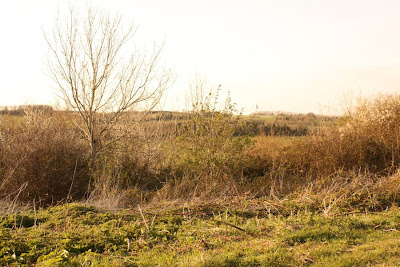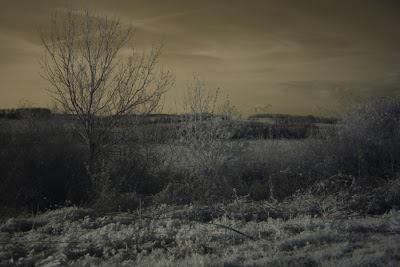I have noticed that the most popular entry page to my blog is my
post on
infrared photography with the
Canon EOS 450D (Digital Rebel XSi in the US). I have also been asked via email and blog comments various questions on this topic so I thought I would write some follow up posts on the subject.
I am by no means an expert in this subject but will attempt to cover the steps I take when shooting infrared photographs using the
450D.
Infrared photography is a lot harder on the
Canon EOS 450DCanon 450D than on my
Canon Powershot S2 point and shoot. This is mainly due to the 450D having a factory fitted IR cut filter which reduces the infrared light entering the camera. Because of this, slower shutter speeds are required to allow the smaller amount of infrared light entering the camera to show up.
Here is a step-by-step guide of how I take IR photos using a dSLR.
1. Setup a tripod and the camera then compose a shot with AF switched on. Depress the shutter release button half way so that it automatically focuses then release2. Attach the infrared filter with the lens AF still in the On position - This reduces the movement on the focusing ring when screwing on the filter as it is locked when the AF is switched on3. Remove viewfinder eye piece from the back of the camera (this just slides off upwards) and attach the rubber cover that is on the neck strap. This will prevent additional light entering via the viewfinder4. Switch the AF on the lens to the Off position as the camera will not be able to auto focus with the filter attached and we have already composed and focused the shot 5. Set the camera to M (manual) mode then adjust the settings for shutter speed and aperture and take some test shots until you are happy with the amount of light in the shot. Once enough light is coming through you will notice that the shots are very orange or red in colour. That is nothing to worry about - we will rectify this in the next steps6. With the same camera settings and the filter still attached you will need to take a photograph of something completely white. A white sheet of paper held in front of the camera for the duration of the exposure will do the job fine7. Press Menu on the camera and go to Custom WB then press Set. The photo that you just took of the white sheet of paper should appear so press Set again to confirm. You may get a warning stating that the 'Correct WB may not be obtained with the selected image' - Just override this and select OK then exit the menu8. Press the WB button on the back of the camera and select Custom9. Now you are ready to take some shots. If you have a remote or cable release then use it to avoid any camera shake when you press the shutter release. If not then just set the auto timer to 2 or 5 seconds so that you are not touching the camera when the shot is taken.10. You now have the perfect shot!This will still involve a lot of trial and error but I've found it to be a good basis. You can also substitute different colours for the custom white balance (other than white) to get various results.
The example infrared shots below were taken with the standard 19 - 55mm kit lens and a 58mm Kood infrared filter.
Here is the shot without the filter. Pretty boring!

Here is the IR shot straight from the camera - Taken using 30 second exposure, an aperture of f/4.5 and ISO set to 100.

Here is the same image again but with some post processing I have swapped the red and blue channels (something which seems to improve infrared shots taken on the 450D). I have also carried out some manual colour correction to make the grass and shrubs look lighter and increased the hue to brighten up the sky.

Here is another example shot using the same camera settings and post processing methods.
 Part 1
Part 1 of this post can be found
here and I will also soon publish Part 3 where I will cover the common questions which I have been asked so far.












13 comments:
Hey Steve I just stumbled across your blog via "IR photo with 450D" (surprise surprise), nice follow up there gave me a better idea about IR with my 450D as Im trying to find a filter as I cant afford to have my only camera modified. Keep the great work up! Im sure there are a lot of other people will be interested in the info!
@Anonymous,
Many thanks for your comment and I'm glad that you found the post useful.
just another comment to say thanks for the blog - have a 450D and want to get an infrared filter so it is reassuring that something can work
Thanks a lot for the info here guys, As i did ir shooting with my sony dcs-f828 I still had the hoya 72 somewhere. I put it on my 450d with ef 28-135 attached and Yup IR again :)
check out http://www.flickr.com/photos/gipukan/4256868522/
Gip
Hi Gip,
Glad that you found the information here useful.
Really liked your shots on Flickr.
Steve
Hi Steve,
Your site has turned out to be really useful in regards to IR photography. However, I am still having some issues regarding WB. I own a Canon 450 D too btw.
There is one step in which you state pull up a white sheet of paper and place it infront of the camera with the IR filter. The result I get is that is equivalent to applying the sunlight WB which is already available in the Camera's settings.
I am always getting a green foliage when I shot images at ISO 200, Shutter speed: 5 sec/10 seconds and f-stop of 8.
It would be great if you can help me out here by finding me a way to convert that green foliage (representing plants and trees) is turned to complete white after color swapped on photoshop.
Thanks and hope to hear from you soon!
Cheers!
Baber
Hi Baber,
Glad that you are finding the blog useful.
Are you keeping the white sheet in front of the shutter and taking a picture for the same duration (with the same settings) as you are taking your shots?
It might also be worth trying some longer exposure shots to see what results you get from them.
Hope that helps and if you have any further questions then please ask away.
Many thanks,
Steve.
Thank you for such a wonderful Tutorial. But still I did not quite get the 3d step
"Remove viewfinder eye piece from the back of the camera.."
What is viewfinder eye, and what does it look like? I tried to google it, but it gave me that it's a kind of extra equipment. I can not find anything like it on my Canon 450D.
Hi Маврин
Really glad that you found the tutorial useful.
The eye piece on the Canon EOS 450D is the rubber part over the viewfinder (that you look through). You can slide it upwards to remove it and then there is a rubber cover on the camera strap that slides over the opening to block out any light entering the camera through the viewfinder.
Here is a link to a picture of the removable part that I am talking about... http://www.bristolcameras.co.uk/images/canon-ep-ex15-ii-eyepiece-extender-for-eos-450d-&-1000d-lrg.jpg
Hope this makes it a little clearer for you.
Steve.
Thanx a lot :)
Thank you so much for this info!
Thanks for refreshing my memory on this Steve.
The last time I tried anything like this I was in a darkroom!
I'll give this a go next week some time.
Hi Matt,
Glad that you enjoyed the post and good luck with your infrared photography.
Steve.
Post a Comment